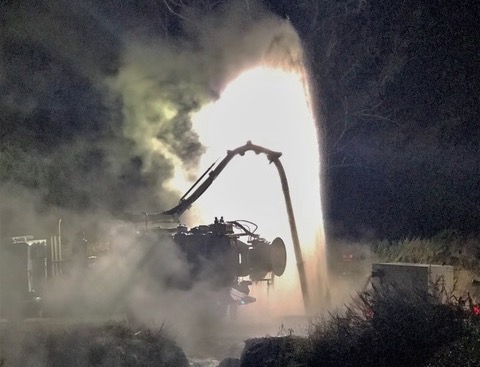
By Rita Robinson, Special to the Independent
After a 30-foot geyser of raw sewage spewed 1.87 million gallons of toxic stew into the ocean at Aliso Creek last Thanksgiving, a penalty settlement between Laguna Beach and the San Diego Regional Water Quality Board is in its final stages before public review.
Declining to give an exact dollar amount, the settlement does include a monetary penalty, said Chiara Clemente, the regional water quality board’s Senior Environmental Scientist and Enforcement Coordinator. Enforcing the penalty is contingent upon the city’s actions to repair the overall problem, she said.
“The settlement does require the city to do certain things,” said Clemente. Calling it a team effort over nearly nine months of negotiations with the city, a draft of the settlement with the monetary penalty will be available for a 30-day public review possibly by the end of the year, she said.
The city has plans to mitigate long-standing sewage eruptions in the 4.2-mile North Coast Inceptor, a sewage pipeline installed in 1989, said David Shissler, the city’s Water Quality Director. The plans are slated for public discussion at the Feb. 16 city council meeting.
The NCI pipeline transmits 1.6 million gallons of sewage daily from Main Beach to Aliso Beach and uphill to the Coastal Treatment Plant in Aliso Canyon.
The legal action was forced by complaints submitted by resident Eric Praske, a stand-up paddling enthusiast, as well as the Laguna Bluebelt Coalition, an ocean conservation organization. The complaints were filed with the state’s Environmental Protection Agency and forwarded to the San Diego Regional Water Quality Board.
At 11:30 a.m. on a stormy Wednesday before last Thanksgiving, a massive plume of sewage shot out of a corroded section of a three-inch-diameter sewer pipe near Ben Brown’s Golf Course at The Ranch in South Laguna. The spill flooded Aliso Creek and rushed into the ocean, closing 16 miles of shoreline over the holiday weekend. Beaches from the Strand in Dana Point to El Moro Creek at Crystal Cove State Beach were reopened the following Monday.
“We call it Poop-ushima,” said Mike Beanan, whose ocean-advocacy organization has been championing modernizing the city’s sewer system for years.
Beanan compared the sewage eruption to a corroded pressure-cooker valve that’s endured constant pressure from water and temperatures, including cold stormwater that creates abrupt temperature changes, since 1989. “You’re supposed to replace those things I’m sure more than every 30 years,” he said. “It inevitably blows.”
After emergency measures, including asking residents to reduce water usage over Thanksgiving Day and redirecting the flow to other pipes to relieve pressure, the leak was stopped just two days after it exploded. The valve involved had been replaced in 2014, according to a city report.
The pipe itself was fixed the following Friday. But concerned residents fear it can happen again. Beanan said he’s concerned about a lack of routine maintenance inspections.
After the 2019 sewage blow-out, improvements were made “to further secure the caps related to the wastewater spill,” said Shissler. Since 2002, the city has spent $54 million improving its overall wastewater system, including the pipes, lift stations, NCI transmission system and the Coastal Treatment Plant, he said.
The discharge of treated wastewater, called secondary sewage, into the ocean still contains toxic chemicals, such as heavy metals and industrial and medical chemical compounds, according to water treatment reports. Beanan said this includes human urinary waste containing residue from medical radiation treatments. The Bluebelt Coalition is working on a proposal for a “zero-liquid discharge system” for waste treatment. “You’re going have to do something for the next 100 years,” he said.
The ultimate goal Beanan said he’s striving for is “no more dumping anything into the ocean.”
He said his group will propose retiring the current canyon treatment plant in the upcoming public forum. The proposal will include sending sewage farther south and up Crown Valley Parkway to the Regional Treatment Plant in Laguna Niguel like other nearby cities do.





The present Coastal Treatment Plant (CTP) would never survive an Environmental Impact Report (EIR) today since it is located at the vortex of Aliso Canyon – a CALfire mapped Very High Wildfire Hazard Area. The CTP is also subject to storm flooding as it is sited at a sharp turn in the creek flow. The $100 mil 2005 SUPER Project to protect sewer pipes along Aliso Creek has been abandoned. Time to modernize for Zero Liquid Discharges to the ocean and implement the City’s September 16, 2014 commitments.
http://lagunabeachcity.granicus.com/MetaViewer.php?view_id=3&clip_id=400&meta_id=30776